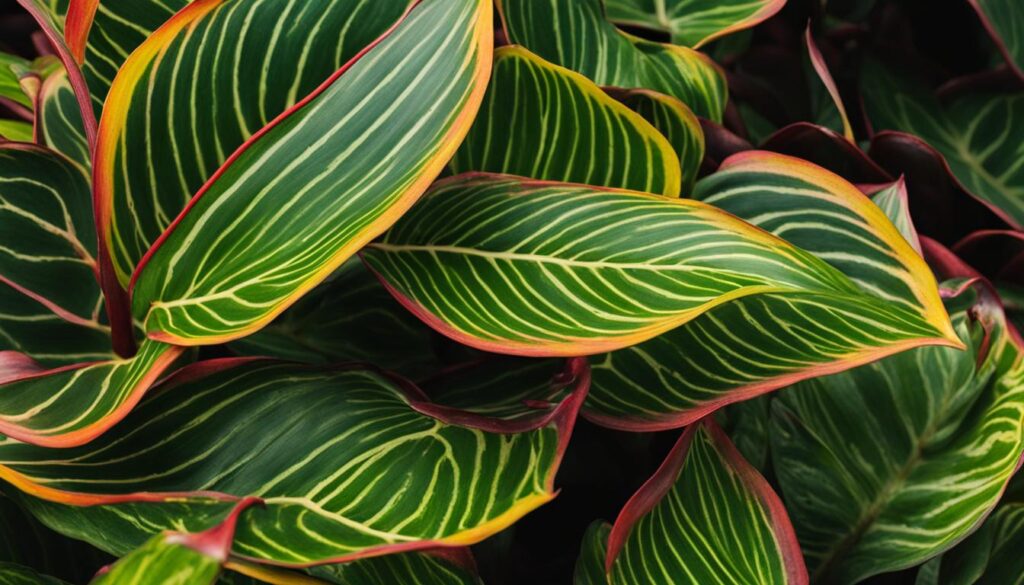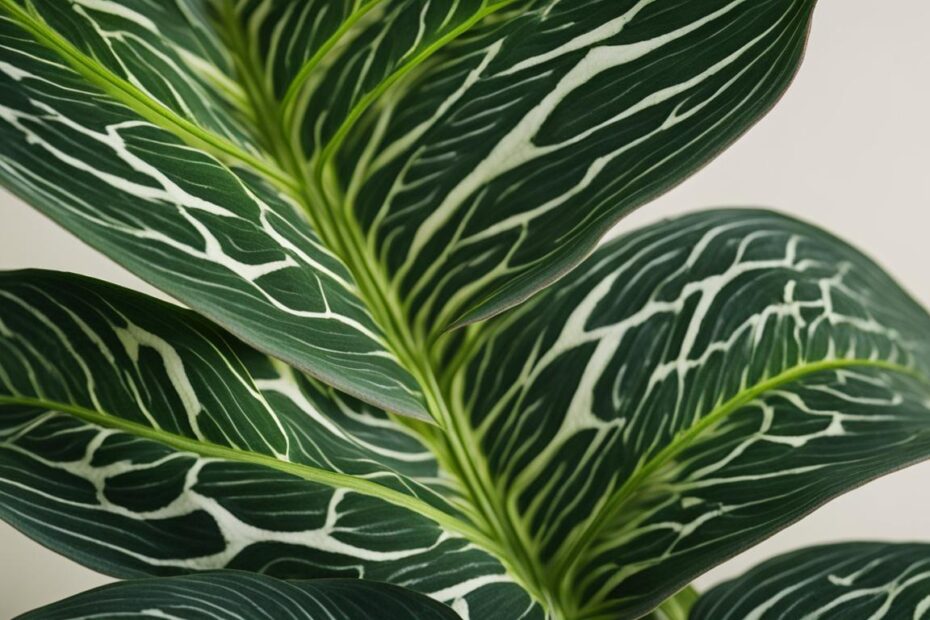The prayer plant, with its intricate leaf patterns and vibrant colors, has a rich history that spans different cultures and time periods. This unique houseplant has captivated the hearts of plant enthusiasts and continues to be a popular choice for indoor gardens. In this article, we delve into the origins, significance, and journey of the prayer plant, uncovering the fascinating historical information that makes it truly remarkable.
Key Takeaways:
- The prayer plant’s history is filled with intriguing facts and origins.
- It originated in tropical regions of the Americas, particularly Brazil and other South American countries.
- The plant was named after Bartolomeo Maranta, an Italian physician and botanist from the 16th century.
- Throughout history, the prayer plant has held spiritual significance and was used in rituals and healing practices.
- The prayer plant has undergone a remarkable journey, adapting well to indoor environments and becoming a beloved houseplant worldwide.
The Origins of the Prayer Plant
The prayer plant, scientifically known as Maranta leuconeura, traces its origins back to the tropical regions of the Americas. This unique houseplant is believed to have originated in countries such as Brazil and other South American nations. The plant derives its name from Bartolomeo Maranta, an eminent Italian physician and botanist from the 16th century, who played a crucial role in its discovery and recognition.
During Maranta’s time, the prayer plant gained prominence for its distinctive leaf patterns and vibrant colors. Its mesmerizing foliage captivated botanical enthusiasts and researchers alike, contributing to its inclusion in the Marantaceae family. The history of the prayer plant’s origins provides insights into its remarkable journey from the tropical regions to becoming a beloved houseplant worldwide.
To further appreciate the prayer plant’s historical significance, it is essential to explore its cultural and spiritual ties in various societies. Native American cultures revered the plant for its spiritual properties, incorporating it into rituals and healing practices. It was believed to bring good fortune and protection to those who cultivated it. In Victorian times, the prayer plant gained popularity as a decorative plant, admired for its lush foliage and intricate leaf patterns, adding beauty and charm to homes and gardens.
Today, the prayer plant continues to be highly regarded not only for its aesthetic appeal but also for its air-purifying properties. As indoor environments became more prevalent, the prayer plant adapted well to these settings, making it a sought-after choice for plant enthusiasts worldwide.
The Significance of Prayer Plant in History
Throughout history, the prayer plant has held various significances and has been revered for its aesthetic appeal and symbolic meaning. In Native American cultures, the plant was known for its spiritual properties and was used in rituals and healing practices. It was believed to have the power to bring about good fortune and protection. Native American tribes such as the Shawnee used the prayer plant in ceremonies to connect with nature and seek guidance from the divine. The plant’s vibrant foliage represented the beauty and abundance of the natural world, serving as a link between the physical and spiritual realms.
In Victorian times, the prayer plant gained popularity as a decorative plant. Its striking leaf patterns and colors caught the attention of botanists and plant enthusiasts. The Victorian era was known for its fascination with nature and the exotic, and the prayer plant perfectly embodied this aesthetic. The plant was often showcased in grand gardens and conservatories, where its lush foliage added a touch of elegance and beauty. It became a symbol of refinement and sophistication, and its presence in Victorian homes was a testament to the owners’ taste and appreciation for nature’s wonders.
Today, the significance of the prayer plant continues to resonate with plant lovers around the world. Its unique leaf movement, where the leaves fold up at night like hands in prayer, has captivated the hearts of many. The prayer plant is not only admired for its aesthetics but also valued for its air-purifying properties. It helps to improve indoor air quality by filtering out toxins and releasing oxygen, creating a healthier and more vibrant living space. As people increasingly prioritize wellness and the connection to nature, the prayer plant’s historical significance remains relevant and cherished.

The Symbolic Meaning of Prayer Plant
“The prayer plant has long been associated with spirituality and symbolizes the connection between humans and the divine. Its folding leaves resemble hands in prayer, reminding us to seek reflection and balance in our lives. It serves as a gentle reminder to take moments of silence and gratitude, connecting with ourselves and the world around us.” – Botanist Emilie Collins
Table: Prayer Plant Cultural Significance
| Culture | Significance |
|---|---|
| Native American | Used in spiritual rituals and believed to bring good fortune |
| Victorian | Symbol of refinement and elegance in grand gardens |
| Modern | Valued for its air-purifying properties and connection to nature |
The Journey of the Prayer Plant
The prayer plant has undergone a remarkable journey, evolving from its tropical origins to becoming a beloved houseplant around the world. This captivating plant caught the attention of explorers who traveled to different regions, discovering its beauty and charm. As the plant enthusiasts brought it back to their countries, the prayer plant adapted well to indoor environments, establishing its prominence as a popular choice.
Over time, the prayer plant’s popularity grew, leading to the development of various varieties and cultivars. Each of these plant variations possesses unique characteristics and mesmerizing leaf patterns, captivating the hearts of plant lovers globally. The prayer plant’s ability to thrive indoors, coupled with its aesthetic appeal, made it an ideal addition to homes, offices, and gardens.
As the prayer plant’s popularity spread, so did the knowledge and appreciation for its historical background. People began to delve into the rich history of the prayer plant, learning about its tropical origins and the fascinating cultures that valued its beauty and significance. Today, the prayer plant stands as a testament to the enduring allure of nature and the never-ending fascination with the world’s vibrant plant life.
Fun Facts About the Prayer Plant
The prayer plant, with its unique leaf movements and captivating beauty, is a fascinating houseplant that has captured the hearts of plant enthusiasts worldwide. Explore these fun facts to discover more about this remarkable plant:
1. Leaf Movement:
The prayer plant gets its name from the way its leaves fold up at night, resembling hands in prayer. This unique movement is known as nyctinasty and is believed to help protect the plant from potential harm and conserve moisture during the nighttime hours.
2. Family Ties:
The prayer plant belongs to the Marantaceae family, which includes other intriguing plants like Calathea and Stromanthe. These plants share similar characteristics, such as vibrant foliage patterns and the ability to thrive in low light conditions, making them popular choices for indoor gardening.
3. Air-Purifying Abilities:
Besides its aesthetic appeal, the prayer plant is also known for its air-purifying properties. It helps remove toxins from the surrounding air, improving indoor air quality. This makes it an excellent choice for those looking to create a healthier and more vibrant living environment.

With its mesmerizing leaf movement, botanical lineage, and air-purifying abilities, the prayer plant is truly a remarkable addition to any indoor space. Whether you’re a plant enthusiast or someone looking to enhance the beauty and functionality of your home, this captivating houseplant is sure to delight and inspire.
| Fact | Description |
|---|---|
| Leaf Movement | The leaves of the prayer plant fold up at night, resembling hands in prayer. This unique movement is called nyctinasty. |
| Botanical Family | The prayer plant belongs to the Marantaceae family, which also includes other fascinating plants like Calathea and Stromanthe. |
| Air-Purifying Abilities | Alongside its beauty, the prayer plant helps improve indoor air quality by removing toxins from the surrounding environment. |
Conclusion
The prayer plant’s history is a fascinating journey filled with intriguing facts and origins. From its tropical beginnings in the Americas to its widespread popularity as a beloved houseplant, the prayer plant has left an indelible mark on the world of plants and horticulture. Its unique leaf patterns and vibrant colors have captivated people throughout history.
The prayer plant’s significance goes beyond its aesthetic appeal. In Native American cultures, it was revered for its spiritual properties and used in rituals and healing practices. Victorian enthusiasts admired it as a decorative plant, showcasing its lush foliage and intricate leaf patterns. Today, it continues to be cherished for its beauty and versatility as an indoor plant.
As people traveled and discovered the prayer plant’s charm, it made its way to various countries and adapted well to indoor environments. Different varieties and cultivars were developed, each with its distinct characteristics. The prayer plant also has many fun facts, such as its leaf movement resembling hands in prayer and its air-purifying properties.
Understanding the history of the prayer plant allows us to appreciate its beauty even more and recognize the significance it holds in our lives. Whether placed in homes or gardens, the prayer plant continues to bring joy and a touch of nature to our surroundings. Its captivating journey and rich history make it a cherished plant for plant enthusiasts worldwide.
FAQ
What is the origin of the prayer plant?
The prayer plant, scientifically known as Maranta leuconeura, originated in the tropical regions of the Americas, particularly Brazil and other countries in South America.
Why is it called the prayer plant?
The prayer plant gets its name from its unique leaf movement, where the leaves fold up at night, resembling hands in prayer.
What is the significance of the prayer plant in history?
The prayer plant has been revered for its aesthetic appeal and symbolic meaning throughout history. It held spiritual properties in Native American cultures and gained popularity as a decorative plant in Victorian times.
How did the prayer plant become a popular houseplant?
As people traveled and explored different regions, they discovered the beauty of the prayer plant. It was introduced to various countries and adapted well to indoor environments, making it a popular choice for plant enthusiasts.
Are there any fun facts about the prayer plant?
Yes, the prayer plant is part of the Marantaceae family, which includes other fascinating plants like the Calathea and Stromanthe. It also has air-purifying properties, making it beneficial for indoor environments.









